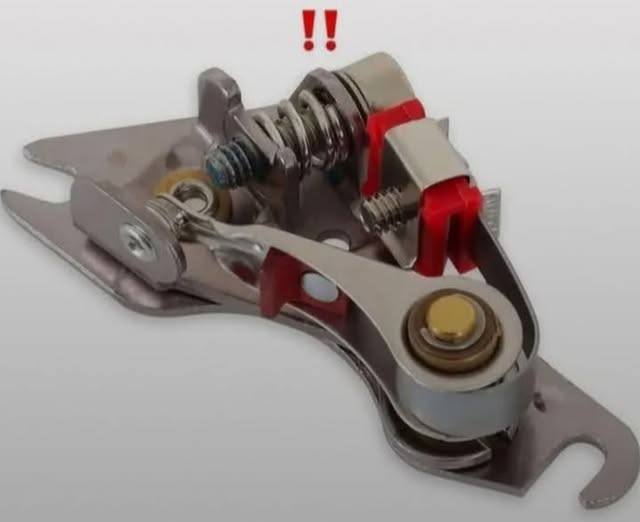The mechanical breaker point system, showcased in the image above, was once a vital component in older ignition systems, playing a significant role in internal combustion engines. This system operated in vehicles before the widespread adoption of electronic ignition systems, and although now largely obsolete, it offers an interesting glimpse into the technological evolution of automotive ignition systems. In this article, we’ll break down how breaker points work, their importance, and why they were eventually replaced by more modern technology.
What Are Breaker Points?
Breaker points, sometimes referred to as contact points, are mechanical switches used to regulate the timing of the ignition spark in older vehicles. Essentially, they consist of two electrical contacts that open and close in sync with the engine’s rotation. These contacts play a key role in allowing the ignition coil to generate the high-voltage spark necessary to ignite the fuel-air mixture inside the engine’s cylinders.
How Do Breaker Points Work?
Opening and Closing Cycle
The breaker points are activated by a cam attached to the engine’s distributor shaft. As the cam rotates, it pushes a breaker arm, which opens and closes the contacts. This action occurs in direct relation to the engine’s rotation.
Inducing Voltage
When the breaker points close, current flows through the primary winding of the ignition coil. The moment the points open, the electrical current is suddenly interrupted, causing a spike in voltage. This sudden voltage change induces a high voltage in the secondary winding of the coil, which is then sent to the spark plugs to create a spark.
Role of the Condenser
A capacitor, often referred to as a condenser, is connected in parallel with the breaker points to help prevent excessive arcing between the contacts. This arcing could lead to wear and reduce the efficiency of the system. The condenser smooths out the electrical current flow, ensuring a more consistent performance.
Why Were Breaker Points Replaced?
While breaker points were a reliable component in their time, several factors led to their replacement by electronic ignition systems:
1. Wear and Tear
Because breaker points are mechanical, their constant opening and closing causes physical wear on the contacts over time. This required regular maintenance, including adjustments and replacements, to ensure proper engine performance.
2. Limited Efficiency
As engine technology advanced, it became evident that the mechanical system of breaker points couldn’t keep up with the increasing demand for precise and reliable ignition timing. Engines became more powerful and required a higher level of accuracy in spark timing to optimize performance, something the breaker points struggled to achieve.
3. Introduction of Electronic Ignition Systems
The advent of transistorized and computerized ignition systems in the 1970s marked the decline of breaker points. These modern systems use solid-state components to control ignition timing with greater precision, improving overall engine performance, reliability, and efficiency. With the elimination of mechanical contacts, electronic systems also reduced maintenance costs and the need for frequent adjustments.
Conclusion
Breaker points were a key part of automotive ignition systems for many years, but as technology progressed, their limitations led to their replacement by more advanced electronic ignition systems. Understanding how breaker points function gives us valuable insight into the history of automotive technology and how much things have evolved over time. Today, we benefit from more efficient, reliable, and low-maintenance systems, but it’s important to recognize the role that older components like breaker points played in the development of modern vehicles.

Sophia Reynolds is a dedicated journalist and a key contributor to Storyoftheday24.com. With a passion for uncovering compelling stories, Sophia Reynolds delivers insightful, well-researched news across various categories. Known for breaking down complex topics into engaging and accessible content, Sophia Reynolds has built a reputation for accuracy and reliability. With years of experience in the media industry, Sophia Reynolds remains committed to providing readers with timely and trustworthy news, making them a respected voice in modern journalism.
